Plant & Animal ID in Florida BS13
Keeping the "outing" in scouting is important. Get into more detail about Florida flora and fauna. Know what to look for and what to avoid.
We are going to approach this from two angles:
1. General plant and animal identification, especially for safety issues
2. Plant and animal identification for Rank Advancement
These are great skill lessons for campouts, since you will be immersed in nature. We will cover common plants, insects, reptiles, mammals and birds, but no fish or amphibians or mollusks. There are a great number of animals not covered here due to lack of space and time.
Tenderfoot Rank Requirements
11. Identify local poisonous plants; tell how to treat for exposure to them.
Second Class Rank Requirements
5. Identify or show evidence of at least ten kinds of wild animals (birds, mammals, reptiles, fish, mollusks) found in your community.
First Class Rank Requirements
6. Identify or show evidence of at least ten kinds of native plants found in your community.
When encouraging Scouts to investigate these flora and fauna, have them “leave them where they found them” and bring you to the item in question. Last thing you want is to have some Scout stung by that cute little velvet ant. You can have them use a digital camera and bring the images to you!
You can develop (or Google) a ton of games and activities to help your group hone their nature skills. At the end of this document are some games, as well many links to help you out.
Poisonous (Or just plain nasty) Plants in North Florida
|
Poison Ivy - it is not true Ivy; it is a woody vine that is well-known for its ability to produce urushiol, a skin irritant that causes an itching rash for most people.
The leaves are compound with three almond-shaped leaflets ("Leaves of three, let it be"). The berries are a grayish-white color and are a favorite winter food of some birds.
The color ranges from light green (usually the younger leaves) to dark green (mature leaves), turning bright red in fall. The leaflets are 3-12 cm long, rarely up to 30 cm. Each leaflet has a few or no teeth along its edge, and the leaf surface is smooth. They are also Asymmetrical, giving them the “folded thumb” appearance
|
|

|
|
|
Poison Oak - Atlantic Poison-oak is an erect shrub that can grow to 1 m (3 ft) tall. The leaves are alternate, with three leaflets on each. The leaflets are usually hairy, and are variable in size and shape, but most often resembling white oak leaves. The leaves are usually 15 cm (6 in) long, turning yellow or orange in autumn. The fruits are small, round, and yellowish or greenish. It can be found growing in forests, thickets, and dry, sandy fields.
|
|

|
|
|
Poison Sumac - is a woody shrub growing to 3 m tall. All parts of the plant contain a toxic resin called urushiol that causes skin and mucous membrane irritation to humans. When burned, inhalation of the smoke causes diarrhea and other internal irritations.
|
|
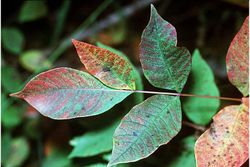
|
|
|
Treatment - Urushiol-induced contact dermatitis is the medical name given to allergic rashes produced by oil urushiol, which is contained in poison ivy, poison oak, and poison Sumac. Symptoms of the rash include itching, inflammation, oozing, and in severe cases a burning sensation. There are up to 50 million cases of urushiol-induced dermatitis annually in the United States alone. Poison oak is a significant problem in the rural western and southern U.S., while poison-ivy is most rampant in the eastern U.S. Dermatitis from poison sumac is less common, but just as problematic.
Primary treatment involves washing exposed skin thoroughly with soap and water. Soap is necessary as urushiol is hydrophobic oil and is not washed off by plain water. Once an outbreak has occurred, cold compresses, Burow's solution, calamine lotion, antihistamines, and hydrocortisone ointment are commonly used to abate the symptoms.
No vaccine has been developed to counter urushiol symptoms, so "cures" are generally held to be those products that physically remove the urushiol. After about 15 minutes of exposure, the urushiol is chemically bonded to the skin and can only be removed with pharmaceutical products, which vary by person in effectiveness: Tecnu and Zanfel are two.
|
|
|
|
|
Stinging Nettles - Stinging nettle, also called bullnettle, spurge nettle, or tread softly. The tiny stinging hairs that cover the plant can cause a reddish rash and painful, stinging sensation if they are touched. While the effects are not serious, the pain may persist for up to an hour. The tubers of the plant are edible but the upper portions should be avoided.
The leaves are simple, alternately arranged, and palmately-lobed with 3 to 5, deep, toothed lobes. Their shape is similar to that of a maple leaf. Whitish veins are evident on the dark green leaf surfaces, while the undersides and margins are covered with venomous, stinging hairs.
Not much treatment options but time. Folksy remedies include grabbing a nearby fern leaf and rub the underside of it against the stinging area. Also urinating on the affected area is supposed to help. Let me know…
|

|
|
|
|
Smilax - Smilax is a genus of about 200 species of climbing flowering plants, many of which are woody and/or thorny, native throughout the tropical and warm temperate regions of the world. Common names include Catbrier, Greenbrier, Prickly-ivy, Sarsaparilla, Sarsaparilla and Smilax
While not poisonous, they are dense and low-lying and are shin-scrapers for boys running through the woods. General cut and scratch first aid applies.
|

|
|
|
|
|
|
|
Poisonous (Or just plain nasty) Animals in North Florida
Venomous Snakes
 There are two types of venomous snakes in Florida: the Crotalidae or pit vipers and the Elapidae. The Crotalidae are readily identified by the facial pits, one located between the eye and nostril on each side of the head. The elliptical eye pupil and broad, roughly V-shaped head are other identifying features of this group. Included in the family are the diamondback rattlesnake, canebrake rattlesnake, pigmy rattlesnake, cottonmouth, and the copperhead. The venom of these snakes is haemotoxic, that is, it destroys the red blood cells and the walls of the blood vessels of the victim. The Elapidae, represented in Florida by the coral snake, have neurotic venom. This attacks the nervous system of a victim, bringing on paralysis.
There are two types of venomous snakes in Florida: the Crotalidae or pit vipers and the Elapidae. The Crotalidae are readily identified by the facial pits, one located between the eye and nostril on each side of the head. The elliptical eye pupil and broad, roughly V-shaped head are other identifying features of this group. Included in the family are the diamondback rattlesnake, canebrake rattlesnake, pigmy rattlesnake, cottonmouth, and the copperhead. The venom of these snakes is haemotoxic, that is, it destroys the red blood cells and the walls of the blood vessels of the victim. The Elapidae, represented in Florida by the coral snake, have neurotic venom. This attacks the nervous system of a victim, bringing on paralysis.
Rattlesnakes: the main rattlers you’ll run into in this area are the Dusky Pigmy, the Eastern Diamondback, and the Canebrake (Southern Timber) Rattler.
|

|
Dusky Pigmy
Average size is 12-24 inches and they range throughout Florida. They are common, found in lowland pinewoods, prairies, around lakes and ponds, and near freshwater marshes and cypress swamps.
This snake has a bad case of Napoleon syndrome; it is very aggressive and will hold its ground. Its bite is not usually life threatening, however it is very painful and tissue loss is common.
|
|
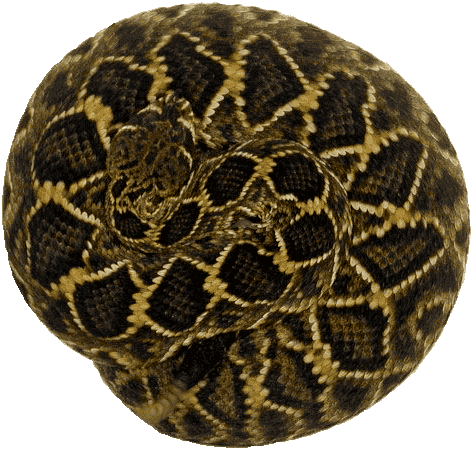
|
Eastern Diamondback
Average size is 36-72 inches and range is throughout Florida including the Keys.
Not endangered, however it is a species of special concern. The population is declining because of habitat reduction along with the indiscriminate killing and commercial hunting for their skins.
This rattlesnake is a large and dangerous snake that can strike up to 2/3 of its body length. If you encounter one stay a healthy distance from it.
|
|
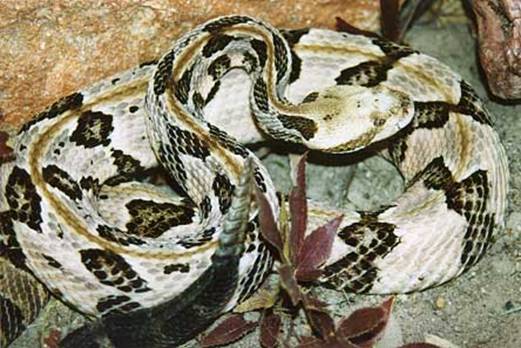
|
Canebrake (Southern Timber) Rattler
A subspecies of the Timber Rattlesnake occurs in lowland areas such as swamps, cane brakes, and riverine thickets rather than the higher elevations of the Timber. The rust-colored dorsal stripe is a good identifying mark on the Canebrake and may be the only noticeable difference between it and the Timber. Average 3 to 4 feet long.
Range: Southern Virginia, south to the panhandle of Florida and west of central Texas.
|
|

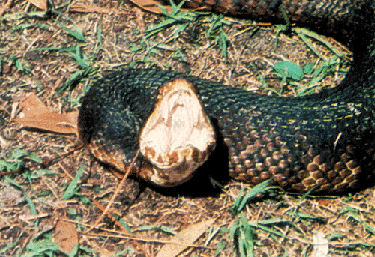
|
Cottonmouth
Average size is and they range throughout Florida.
Status: Fairly common but not often encountered. Found along most waterways including lakes, ponds, rivers, streams, road side ditches, etc. Closely resembles the more common non-venomous Water Snakes.
Cottonmouth bites can be very dangerous, and they are very aggressive. The victim must seek immediate care at a hospital or doctor with snake bite treatment experience.
Main ID: Pit viper head and the “bandit mask”.
|
|

|
Southern Copperhead
Average size 22-36” and they range mainly in the panhandle from the Apalachicola River west. (I have seen them in Gainesville). Still common in some areas. Can be found in suburban areas near people as well as swamps, river beds, etc.
A bite from a copperhead is not usually life-threatening unless it bites a child or someone in poor health, however seek immediate care.
|
|

|
Eastern Coral Snake
In the family of Elapidae, it is not a Pit Viper. Average size is 20-30 inches and it ranges throughout Florida. Common in most areas of the state and in a variety of habitat, but are very secretive and seldom seen. Can be found hiding under leaves, in logs, piles of debris, etc.
It looks like the Scarlet Kingsnake, so remember:
Red touch Yellow,
Kills a fellow
Red touch Black,
Good for Jack
And the nose is black on the Coral Snake.
It has no true fangs, and must gnaw on you to get its venom into your bloodstream.
|
Venomous Insects
|
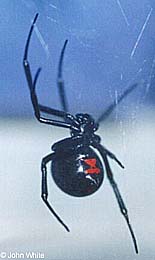
|
Black Widow Spiders
A large female black widow spider can grow to about 1.5 inches, counting leg span. Black widow spiders are common around wood piles, and are frequently encountered when homeowners carry firewood into the house. Also found under eaves, in boxes, outdoor toilets, meter boxes, and other unbothered places.
The female eats the male after mating. She hangs belly upward and rarely leaves the web.
|
|

|
Brown Recluse Spiders
They have a characteristic fiddle-shaped pattern they have on their head region. The spider is golden brown with the fiddle being dark brown or black. This spider is not hairy and the fiddle pattern is often shiny. They are about 1/4 to 3/4 inch long. They are found primarily in the Midwest, but have been seen in Florida.
Many of the wolf spiders are similar in appearance and have similar markings as the brown recluse. They are large, robust, and hairy and, therefore, can be distinguished from the brown recluse.
|
|

|
Fire Ants
Two species of fire ants are found in Florida. Most notorious is the red imported fire ant, followed by the much less common tropical or native fire ant.
They are mound-builders, and are very small and numerous and are swarmers

|
|

|
Wasps, Bees, Hornets
So many forms in Florida and we all know what they look like.
And there is the Velvet Ant, really a wingless wasp.

|
|

|
Walking Sticks
This species is capable of squirting a strong-smelling defensive spray that is painfully irritating to the eyes and mucous membranes. Individuals and mating pairs often were found on scrub palmetto near the connecting point of the fronds.
|
|

|
Florida scorpions
The smallest and most common Florida scorpion is the Hentz striped scorpion found statewide except the southernmost Keys.
Scorpions like to hide outside under boards, rubbish, or other areas that provide shelter and protection. They are active at night and they glow under ultraviolet lights – so get out the black lights to help track them down.
Though not fatal, their sting can be painful.
|
Non-VENOMOUS SNAKES
|
Scarlet Snake

|
Black Racer

|
Ringneck snake
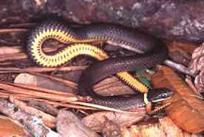
|
|
Indigo Snake
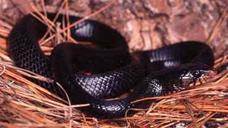
|
Corn Snake

|
Yellow Rat Snake

|
|
Gray Rat Snake

|
Hognose Snake
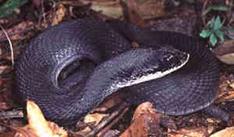
|
Hognose Snake

|
|
Kingsnake

|
Green Watersnake

|
Banded Watersnake

|
|
Pine Snake

|
Garter Snake

|
Eastern Coachwhip Snake
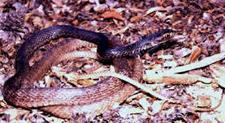
|
Try http://www.flmnh.ufl.edu/herpetology/FL-GUIDE/onlineguide.htm for a great Florida Snake Guide
Plant Identification in Northeast Florida
|
Leaf & Fruit
|
Tree
|
Description
|
|

|

|
Loblolly Pine: The needles, three to nine inches long, are borne three in a cluster; in the spring, bright green clumps of them at the ends of the branches give a luxuriant appearance to the tree. The fruit is a cone, or burr, about three to five inches long. The bark is dark in color and deeply furrowed, and often attains a thickness of as much as two inches on large-sized trees.
|
|
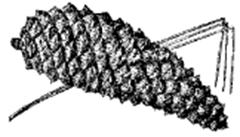
|

|
Longleaf Pine: The needles are from 6-17 inches long, in clusters of three, and gathered towards the ends of the thick, scaly twigs.
The cones, or burrs, are six to ten inches long, slightly curved, the thick scales armed with small curved prickles. The cones usually fall soon after the seeds ripen, leaving their bases attached to the twigs. Bark tends to be gray.
|
|

|

|
Pond Pine: The needles occur in clusters of three, or occasionally two or four intermixed and range in length from five to eight inches. The cones, or burrs, when open are noticeably globular in outline, somewhat flattened, two to three inches long. The bark is dark red-brown and irregularly divided by shallow furrows.
|
|
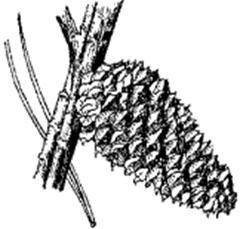
|
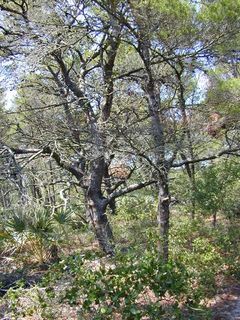
|
Sand Pine: The needles are two in a sheath, two to three inches long, slender, and dark green. The fruit is a cone, or burr, about two to three inches in length, and persists in the tree for a long time. Some of them open when mature, while others remain closed for two to four years, and still others remain closed and even become overgrown and embedded in the wood. It is a small, often shrubby tree from 5-10m. The bark is rough and dark colored over the lower part of the tree, but light reddish or ashy gray on the young branches and twigs.
|
|

|

|
Shortleaf Pine: The leaves are in clusters of two or three, from two to five inches long, slender, flexible, and dark blue green. The cones or burrs are the smallest of all our pines, one and one-half to two and one-half inches long, oblong, with small sharp prickles, generally clustered, and often holding to the twigs for three or four years. The small seeds are dark brown and have a wing, which is broadest near the center. The bark is brownish red, broken into rectangular plates; it is thinner and lighter-colored than that of loblolly pine.
|
|

|

|
North Florida Slash Pine: The trunk is straight, clears itself easily of branches, and is crowned with numerous small branches forming a round-topped head.
The needles, which occur in clusters of two or three in a sheath, are from 4 to 11 inches long, dark green, shiny, and thickly-set on the branches, forming a dense head.
The cones are mostly three to six inches long, brown, and glossy or varnished; the thin scales are armed with fine prickles. Slash Pine may best be distinguished from all other pines by these characteristics of its leaves and cones.
|
|

|

|
Black Oak: The Black Oak, sometimes called 'yellow-barked oak,' grows to be about 80 feet in height and one to three feet in diameter. The crown is irregular shaped and wide, with a clear trunk for 20 feet or more on large trees. The bark on the very young trunks is smooth and dark brown but soon becomes black, with deep furrows and rough broken ridges. The bright-yellow color and bitter taste of the inner bark, due to tannic acid, are distinguishing characteristics.
The leaves are alternate, simple, four to eight inches long and three to six inches wide, shallow or deeply lobed, the shape varying greatly. When mature, the leaves are dark green and shiny on the upper surface, pale on the lower, more or less covered with down, and with conspicuous rusty brown hairs in the forks of the veins.
|
|
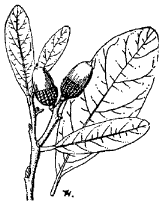
|

|
Live Oak: It is a tree of striking character from its wide-spreading habit, sometimes reaching more than 100 feet in spread; with a short, stout trunk, three to four feet in diameter, dividing in several large limbs with nearly horizontal branches, forming a low, dense, round-topped head. Its height is commonly from 60 to 80 feet.
The bark on the trunk and large branches is dark brown tinged with red, and roughly ridged and furrowed. It grows to largest size on the rich hammocks and low ridges near the coast only a few feet above the water level.
|
|

|

|
Swamp Laurel Oak: one of the more common and the most beautiful of all the oaks. It is found on the banks of streams and in or near swamps and rich hammocks all over the state except in the extreme southern portion. It is a large tree, frequently reaching a height of 100 feet and a trunk diameter of three to four feet, with slender branches forming a broad, dense, round-topped, shapely crown.
The bark of young trees is dark brown, more or less tinged with red, roughened by small close scales, becoming on older trees nearly black and broken into broad flat ridges. The leaves are from one to five and one half inches long and two thirds to over two inches wide.
|
|
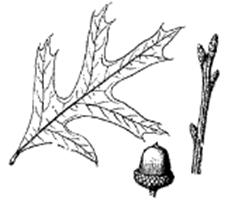
|
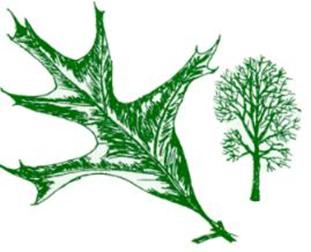
|
Turkey Oak: The Turkey Oak is abundant and reaches good size on dry sandy ridges and sandy bluffs and hammocks in the coast region. It is usually 20 to 30 feet high at maturity, with a trunk a foot and a half to two feet in diameter. Its branches are stout, spreading and more or less controlled, forming an open irregular but generally round-topped crown.
The leaves are deeply divided into three, or five, or rarely seven lobes, spreading and tapering from the base; and average about five inches long as well as wide. They are thick and rigid, heavily veined, bright yellow-green and lustrous above. They are very characteristic and not easily confused with those of any other tree.
|
|

|
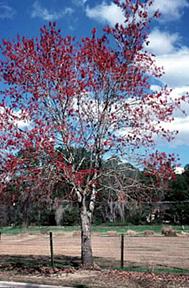
|
Florida Maple: It is found on hammocks and good forest soil, reaching a height over 50 feet, with a trunk up to two feet in diameter. The bark on the trunks is gray, in old trees becoming darker and deeply furrowed.
The leaves are opposite on the stem, three to five lobed, thin, dark green and shiny above, grayish and downy below. They are from two to three inches in diameter, generally rounded in outline, and turn yellow or scarlet in the autumn before dropping from the trees.
|
|
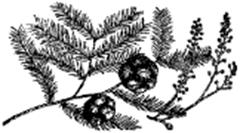
|

|
Bald Cypress: A tree found in deep swamps which are usually flooded for long periods at a time, and on wet stream banks and bottom lands. Its straight trunk with numerous ascending branches and narrow conical outline makes the tree one of considerable beauty. In old age, the tree generally has a broad fluted or buttressed base, a smooth slowly tapering trunk and a broad, open, flat top of a few heavy branches and numerous small branchlets. The bark is silvery to cinnamon-red and finely divided by numerous longitudinal fissures. The leaves are about one-third to three-fourths of an inch in length, arranged in feather-like fashion along two sides of small branchlets, which fall in the autumn with the leaves still attached.
|
|
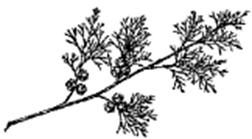
|

|
Atlantic White Cedar: it is found in year-round swamps and occurs with Bald Cypress and deep swamp hardwoods. The branches are very short and horizontal, so that even when grown in the open the tree has a long, narrow, conical shape.
The leaves are minute, scale-like, overlapping, four-ranked, of a bluish-green color, and entirely cover the ends of the slender, drooping twigs. The bark is quite thin, varies in color from ashy-gray to light reddish-brown, and readily separates into loose plate-like scales, which easily peel off in long fibrous strips.
|
|
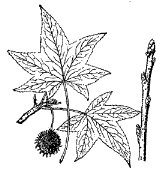
|

|
Sweetgum: It occurs on hammocks, rich river bottoms, and in swamps subject to overflow, as well as on drier lands. The bark is a dark gray, roughened by corky scales, later becoming deeply furrowed. After the second year the twigs often develop two to four corky projections of the bark, which give them a winged appearance.
The simple, alternate, star-shaped leaf, with its five to seven points or lobes, is five to seven inches across and very aromatic. In the fall its coloring is brilliant, ranging from pale yellow through orange and red to a deep bronze.
The fruit measures an inch or more in diameter and is made up of many capsules with projecting spines. It frequently hangs on the tree by its long swinging stem late into the winter.
|
|
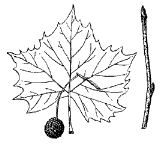
|
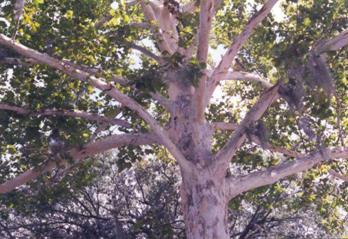
|
Sycamore: is one of the largest hardwood trees in North America. It occurs over northern Florida on stream banks and is one of the more rapid-growing trees. In maturity it occasionally attains a height of 140 to 170 feet and a diameter of 10 to 11 feet. It often forks into several large secondary trunks, and the massive spreading limbs form an open head sometimes 100 feet across. The bark of the Sycamore is a characteristic feature. On the younger trunk and large limbs it is very smooth, greenish gray in color. The outer bark yearly flake off in large patches and exposes the nearly white green or tan younger bark. Near the base of old trees the bark becomes thick, dark brown and divided by deep furrows.
|
|

|

|
Sabal Palm, Cabbage Palm (palmetto): It is a large robust palm with a single unbranching trunk that grows to about 50 ft. The crown is relatively small being 12-18 ft in diameter. Like many palms the crown is typically wider when grown in shade and more compact when grown in full sun.
The large leaves have a dull finish and are a medium green, sometimes yellow-green, in color depending on the individual and situation. Each leaf is up to 12 ft (3.7 m) long overall including the spineless petioles (leaf stems).
This is the Florida State Tree.
|
MAMMAL Identification in Northeast Florida
|
Animal
|
Tracks
|
Scat
|
Description
|
|

|
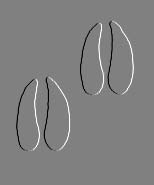
|

|
White-tailed Deer
Medium-sized deer recognized by the white underside to its tail, which it shows as a signal of alarm by raising the tail during escape. The male (buck) usually weighs from 130 to 220 pounds and the female (doe) usually weighs from 90 to 130 pounds
|
|

|

|
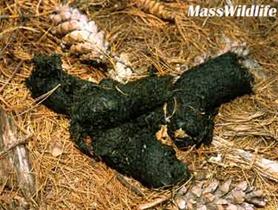
|
Black Bear
Smallest American bears, and the most common. They are usually nocturnal, but can be active during the day, are strong, agile, and quick. They swim and climb trees well, and can run 30 miles per hour in short bursts.
|
|

|

|

|
Opossum
Opossums are the only North American marsupials, and have pointed noses and prehensile naked tails. They have opposable thumbs on their hind feet and have the most teeth of any North American mammal. When attacked, they play dead, or "play possum" and drool and emit an unpleasant smell.
|
|

|
 
|

|
Raccoons
Raccoons are familiar animals with masked faces and ringed tails. They have five toes on both the front and hind feet with dexterous fingers enable them to open latches, untie knots, turn doorknobs, and open jars. Their prints look like tiny human baby handprints and footprints.
|
|

|
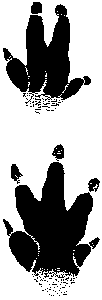
|
Since its tongue is not selective, the feast includes an occasional earthworm, snake or skink, as well as rocks and earth. The armadillo's scat, understandably, resembles clay marbles.
|
Armadillos
About the size of a small dog, the armadillo is covered with bony shell which acts like armor. Armadillos have powerful claws for digging up their dinner, mostly insects and their larvae. They make a lot of noise while foraging and are fairly easy to sneak up on. When surprised they will leap straight up in the air to startle any attacker. The armadillo is the only animal, aside from humans, known to carry leprosy.
|
|

|

|
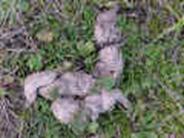
|
Coyotes
Once confined to the west, the coyote has spread all over North America, due partly to wolf extermination. Close relative of the domestic dog, very similar to the "red wolf" in profile. They will respond to human calls, most often after the coyotes have started a howling session.
|
|

|

|

|
Bobcats
Bobcat tracks show four toes on the front foot and four toes on the hind foot, no claws showing because they are retractable. Bobcats are active any time. They are seen in the daytime, but do a lot of hunting at night.
|
|
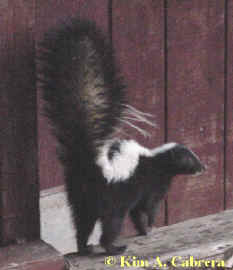
|
 
|

|
Skunks
The striped skunk is a nocturnal animal whose defense is a very strong smelling spray, based on methyl mercaptan. It stamps its feet, growls, hisses, turns its back, and raises its tail straight up when it is about to spray. It can spray up to 15 feet and the smell can carry a mile. If the spray gets in the eyes, it causes pain.
|
|

|

|

|
Squirrels
Gray above, white below; head, legs, and sides washed with tawny brown. Eye ring buffy; tail long, bushy, grizzled blackish and white. Vocal; gives variety of chattering and clucking calls. Very commonly seen mammal.
Sign: Summer-stick platform in tree; gnawed nutshells. Winter-spherical leaf nest in tree; holes in snow above nut caches.
Habitat: Broadleaf and mixed woods, towns.
Activity: By day, year-round.
|
REPTILE Identification in Northeast Florida
|
Animal
|
Description
|
|

|
Gopher Tortoises
This species lives in burrows it constructs in upland areas, which unfortunately (for the tortoises) are prime areas for development. The Gopher Tortoise is considered a "Keystone" species because its burrows, both those in use and ones abandoned by the tortoises, are used by many other animals. Gopher Tortoises usually remain close to their burrow and when disturbed will often make a run for cover.
Do not relocate tortoises on your own! There is a disease (URD Upper Respiratory Disease) in Gopher Tortoises that can be fatal to them. Do not chance that you will pick up a seemingly healthy, but infected, tortoise and move it to an area with uninfected tortoises. Thereby spreading the disease.
|
|

|
Peninsula Cooter: maximum length to 16 inches; top of shell (carapace) uniformly dark with pattern of parallel yellow lines stretching out toward the sides, yellow markings frequently hidden by algae and moss growing on shell; high point of shell is one-third back and then slopes gradually to rear; jaw straight across rather than notched like Red-bellied Turtle. This is the turtle you see all over logs in the rivers and lakes. Similar looking turtles include the Chicken Turtle, Florida Red-bellied Turtle
|
|

|
Florida Red-bellied Turtle: maximum length to 15 inches; bottom of shell (plastron) yellow with red to orange to dark pink in center; usually one large dark red splotch on each segment (scute) on top (carapace) of shell; in older turtles, the red coloration on top darkens and is often hidden by algae and mosses that grow there; young turtles' shells are brightly colored and rounder; shell highest in middle; beak noticeably notched; males have long claws and long stout tail while females have very short claws and small tails; head markings-- single yellow stripe from nose down middle of head, no other yellow stripes on top
|
|
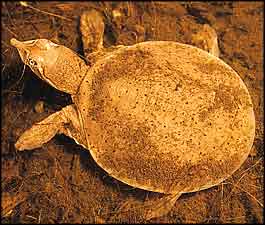
|
Florida Shoftshell Turtle: maximum length to 24 inches; flat, pliable leathery shell; very long neck and long, snorkel-like snout; coloration varies-- shells of young may be all dark or mottled; adults shells get darker with age and frequently lose any patterns; although have soft lips, have very strong jaws and bite can rival that of snapping turtle; long necks enable it to reach almost to back of shell to protect itself; can run on land with surprising speed and agility
|
|

|
Florida Snapping Turtle: maximum length 19 inches; tail has three pointed ridges running lengthwise; long flexible neck which can easily reach sides of shell or bend back to reach top; usually spends its time at the bottom of ponds and lakes; shell color may vary from almost black to light brown; relatively placid under water but ill-tempered and quick to strike when on land (they will take your finger off!); well-camouflaged under water. Similar to the Alligator Snapping Turtle and northern Common Snapping Turtle.
|
|

|
Alligators: Commonly found lurking along grassy banks or peering from beneath Florida's freshwaters, the American alligator, Alligator mississippiensis, is perhaps the state's most recognizable native denizen. The massive crocodilian is the largest of all contemporary reptiles (including its local crocodile and caiman cousins): its black to grey body can weigh 500 pounds and grow more than 18 feet long.
When left alone by humans, alligators thrive in Florida's natural and even its artificial fresh waterways. These cold-sensitive aquatic reptiles are restricted to wetlands in the southeastern United States and are primarily found in Florida and coastal Georgia and Louisiana.
Although alligators are usually solitary, they abide by a complex social hierarchy. Large males, or bulls, tend to stay in open water, and may occupy more than two square miles. Females have smaller territories and frequently inhabit small ponds.
|
|
 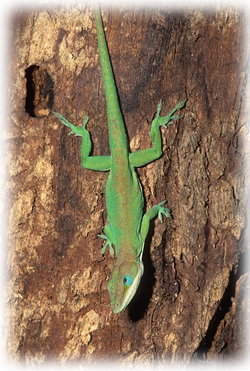
|
Anoles:
Anolis carolinensis - Green Anole
Anolis sagrei sagrei - Cuban Brown Anole
Like all lizards, anoles are equipped with moveable eyelids and external ear holes. Adults molt about every month, casting off skin in bits and pieces. Their feet differ from most lizards in that each toe has adhesive pads (lamellae) on its central portion, enabling the anole to climb and cling to vertical surfaces such as walls, fence posts, trees and leaves, on which they spend much of their time.
Green and Cuban Brown anoles are generally about 5 to 8 inches long. Females are usually smaller and can be less than 5 inches long. The long, slender tail of the anole (which makes up about half of its length) may break off at the slightest pressure and continue to wiggle on the ground, distracting would-be predators. But, no fear, the lizard's tail grows back over several weeks to once again serve as a quick get-a-way aid.
Another striking feature of the anole is its dew lap, or throat fan. It is attached to the throat and displayed by means of a flexible rod of cartilage which can be swung downward and forward, thereby revealing a brightly colored patch of skin. Males display their dew lap during courtship and when defending territory. This display is often accompanied by a series of head-bobs and push-ups.
Cuban Anoles are displacing the Green Anoles as they move north through Florida.
|
|

|
Skinks
Juvenile skinks have bright blue tails. This is one of three species which are nearly indistinguishable --
□ Five-lined Skink
□ Southeastern Five-lined Skink
□ Broad-headed Skink
All three of these species can be found in north Florida.
The Southeastern Five-lined Skink is the most common within the state of Florida; the Five-lined Skink is the least common. The Broad-headed Skink grows to 12 inches; the other two only to 8 inches. The Broad-headed Skink is the only one of the three which climbs high into trees. The Five-lined Skink has wider stripes than the other two.
Skinks are very toxic to cats, and will kill them within about 12-24 hours of ingestion.
|
|

|
Broad-headed Skink
Fully mature skinks lose their stripes.
This is probably a Broad-headed Skink, but is hard to distinguish from a Five-lined Skink or a Southeastern Five-lined Skink.
|
|
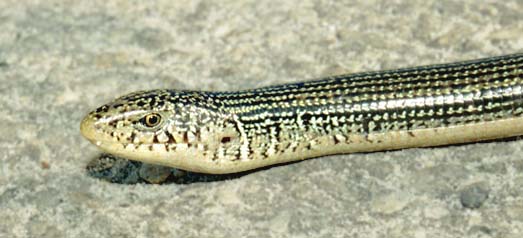
|
Eastern Glass Lizard:
Glass lizards are legless lizards which are found in the southeast quadrant of the United States -- from central Texas to the Atlantic Ocean and north into Illinois.
Juveniles have stripes which change to speckles as the lizard matures. This glass lizard has matured to the point where it is beginning to take on a greenish tint.
Features that distinguish Glass lizards from snakes:
· They have eyelids
· They have ears
· Their sides meet their bellies at a right angle
|
|

|
Eastern Fence Lizard: There are 22 species of Fence Lizards (genus Sceloperus) found in North America. Many of these species are similar in appearance. This genus of lizard can be found as far north as Washington State.
The Eastern Fence Lizard is found from east Texas to the Atlantic Ocean and as far north as southern sections of the states of Illinois, Indiana, Ohio, Pennsylvania, and New Jersey. At one time Sceloperous undulatus was divided into seven sub-species. The sub-species found in Georgia and north Florida was called the Southern Fence Lizard. The current thinking is that there is no basis for sub-species.
|
|

|
Florida Scrub Lizard: These lizards are found in a few locations in central Florida and along part of the Atlantic coast of Florida. They are not found in the Everglades or Big Cypress area. The Eastern Fence Lizard and the Florida Scrub Lizard are very similar in appearance. The Florida Scrub Lizard can be identified by the dark area on each side.
|
BIRDS OF PREY Identification in Northeast Florida
In Flight
|
Perched
|
Description
|
|

|

|
Red-shouldered Hawk (Adult): In Florida, they nest mostly in cypress swamps and river bottomlands. It most frequently still-hunts from a relatively low, inconspicuous perch but may also forage from a low, coursing flight. Its diet is characterized by sluggish, easily captured animals, such as toads, frogs, snakes, rodents, and small birds and their nestlings.
Typical nest sites are located in large mature trees with good canopy cover. A bulky well-built nest is usually placed a little more than halfway up the tree in a major fork. Usually two whitish eggs marked with brown are laid and incubated for approximately 33 days. The young birds fledge at 40 to 45 days of age. They breed from January through May or June. Most birds reside in Florida, but the states' population is augmented in September and October by fall migrants from northern states.
|
|
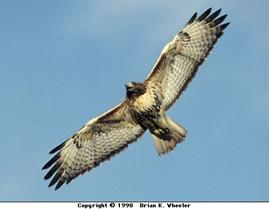
|
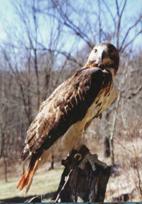
|
Red-tailed Hawk (Adult): The Red-tailed Hawk is commonly found in mixed forest and farmlands. Food habits of this opportunistic species reflect the relative availability of prey in a given area, but its diet is typically dominated by small mammals such as mice, rats, squirrels, and rabbits.
Most Red-tailed Hawks select wooded uplands as nest sites, but in Florida they sometimes nest in cypress tree islands, Australian pine shelter-belts, residential areas, or on power poles. The nest is a bulky, flat-topped structure of coarse sticks, and its diameter is frequently greater than 30 inches. One to 3 (typically 2) white eggs, sometimes marked with brown, are laid and incubated for 32 to 34 days. The young fledge at 43 to 47 days of age.
|
|

|
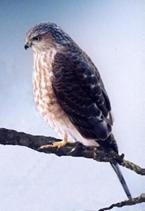
|
Sharp-shinned Hawk (Adult): The Sharp-shinned Hawk inhabits areas of open woodland or dense forest with occasional openings. The Sharp-shinned Hawk feeds almost exclusively on birds from warbler size to dove size, which may be even larger than the hawk.
The Sharp-shinned Hawk most often nests in a stand of coniferous trees situated near an opening in the vegetation. The nest, made of sticks and twigs, is located in the center of a tree. The 4 or 5 white or bluish-white eggs are marked with brown and incubated 32 to 35 days, and the young fledge in 24 to 27 days. The Sharp-shinned Hawk resides in Florida mostly in the winter, arriving in August or September and remaining until April or May.
|
|
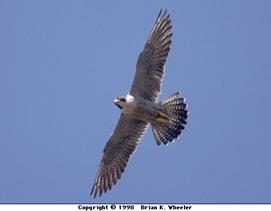
|
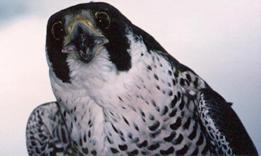
|
Peregrine Falcon (Adult): is a medium-sized falcon about the size of a large crow: The Peregrine Falcon is the fastest creature on the planet in its hunting dive in which it soars to a great height, then dives steeply at speeds in excess of 185mph. Peregrine Falcons feed almost exclusively on birds, such as doves, waterfowl and songbirds, but occasionally they hunt small mammals, including bats, rats, voles and rabbits. Peregrine falcons don't breed in Florida, but like many northern breeders, some spend the winter here. They are regularly spotted during spring and fall migrations.
|
|
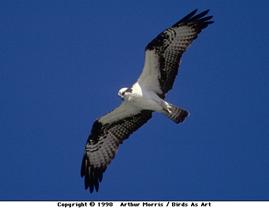
|
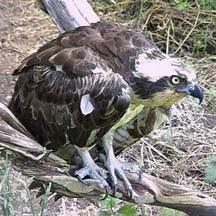
|
Osprey (Adult): The Osprey is a large, fish-eating raptor intermediate in size between the Bald Eagle and Red-tailed Hawk. Ospreys are typically associated with permanent water habitats, especially sea coasts, impoundments, lakes, rivers, and swamps. Breeding habitat requirements include open expanses of water that support abundant slow-moving fish, water clarity sufficient to allow visual detection of fish, and elevated or inaccessible sites for nest-building. Ospreys consume fish almost exclusively, although crustaceans, frogs, turtles, birds, and rodents are occasionally taken. Osprey nest sites are highly variable, but in Florida the birds prefer either dead trees or living trees with broken or dead tops.
|
|

|
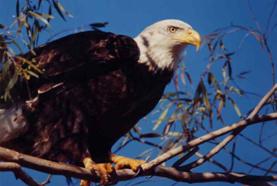
|
Bald Eagle (Adult): Many of Florida's breeding eagles are permanent residents, while others migrate north during the summer. In Florida, a typical nest sites is located near a large body of water in a tall living pine or cypress tree that offers good visibility of the surrounding area. Nests are initially constructed of branches and twigs and are later lined with fresh moss, grasses, and leaves. Nests may be located in remote "pristine" habitats, semi-rural areas, ranchlands, suburbia, and, infrequently, in urban environments. Several recent nests have been located literally in the backyards of residential neighborhoods. Successful breeding usually does not occur until the adults reach at least 5 or 6 years of age.
|
|
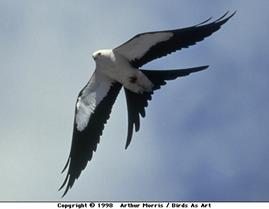
|

|
Swallow-tailed Kite (Adult): Though relatively few in number, Swallow-tailed Kites are quite conspicuous in their captivating aerial grace. Habitats include: swamp and floodplain forests; mixed stands of conifers and hardwoods; the margins of rivers, streams, and lakes; hardwood hammocks; bayheads; sloughs; and mangroves. The breeding season diet consists of insects, anoles, frogs, snakes, nestling songbirds, and a small number of mammals. Insects are the mainstay of fledged juveniles and adults that are not feeding young. Nests are built mainly in pine and cypress trees that emerge above the canopy of fairly open stands. Nests are made of small sticks and large amounts of moss and lichens and are located near the top of one of the tallest available trees.
|
|
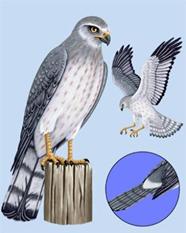 Male Male
|
 Female Female
|
Northern Harrier: The Northern Harrier (Marsh Hawk) breeds throughout much of Canada, the western US, and Kentucky, Virginia, and West Virginia. It is an abundant wintering species throughout most of Florida, but a rare summer resident, and is thought to breed sporadically in northern Florida. They feed on rodents, small birds, snakes, frogs, and large insects, which they startle or flush as they slowly quarter back and forth a few feet above the vegetation in old fields, pastures, and marshes
|
|

|
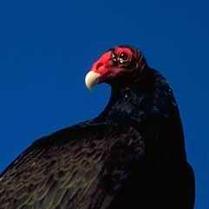
|
Turkey Vulture (Adult): Nesting habitat in Florida is chiefly dense stands of saw palmetto in or near open pine woods, fallen hollow logs, and, occasionally, caves, rock ledges, and abandoned buildings. No nest is constructed; the 1 to 3, most often 2, whitish eggs, often marked or stained with brown, are laid on the bare surface. Incubation takes approximately 38 to 41 days, and the young birds fledge at about 2 months of age. Turkey Vultures feed on carrion found on highways, pastures, and at dumps. Occasionally, they will eat vinyl materials such as roofing covering, pipe insulation, and boat seat cushions, even though such materials contain no nutritional value. Apparently these materials emit an odor, which to the vultures, at least, is similar to that of rotting flesh.
|
|
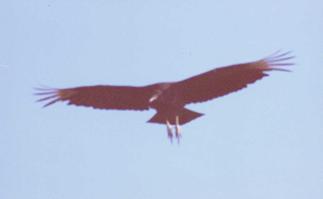
|
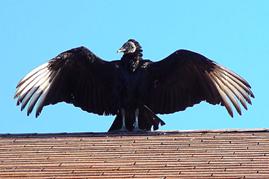
|
Black vulture (Adult): Black Vultures nest on the ground in wooded habitats, in caves or rock crevices, in abandoned buildings, or in saw palmetto thickets in open pinewoods. No nest is constructed. The eggs are laid directly on the bare ground, in a hollow stump or fallen log, or, in hilly country, on a rocky ledge. Incubation requires 37 to 48 days, and the young fledge at 80 to 94 days. The Black Vulture's diet consists chiefly of carrion found along roads, in open countryside, and at landfills. Occasionally, it will take live young mammals and birds and, more rarely, piglets or calves as they are being born.
|
|
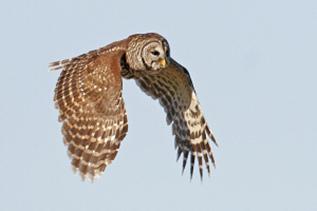
|

|
Barred Owl: Easily identified by its "Who cooks for you, who cooks for you-all" call, the Barred Owl is probably Florida's best-known owl. Unlike other Florida owls, Barred Owls frequently vocalize in the daytime. Barred Owls are found in moist woodlands, prairie hammocks, cypress swamps, bayheads, and along rivers, streams, and creeks. The birds often leave the woods at dusk and hunt their prey in open fields or even among the houses of small settlements.
Barred Owls nest in tree cavities or in abandoned hawk or squirrel nests. On rare occasions, a pair will nest on the ground (Stevenson and Anderson 1994). A typical clutch consists of 2 white eggs, but 3 eggs are found in some nests. Incubation lasts 28 to 33 days, and the young fledge at 42 days of age.
|
|

|

|
Screech Owl: A common resident throughout the state, the Eastern Screech-Owl is Florida's smallest owl. It occurs in suitable habitat everywhere in the state except the Lower Keys. Three color morphs occur: red, brown, and gray although there is considerable variation within each. All 3 color forms may occur in the same nest.
This species is found in all types of wooded habitats, including suburban backyards. Eastern Screech-Owls feed on a variety of animals including insects, lizards, mice, and small birds. Eastern Screech-Owls nest in tree cavities, but readily accept artificial nest boxes. Although 2 to 4 all-white eggs may be laid, the usual clutch is 3 eggs. They are incubated for 26 days, and the young fledge at 27 days of age.
|
|

|

|
Great Horned Owl: At Florida's largest owl, it is a fierce nocturnal hunter. Known as "winged tigers among the most pronounced and savage of birds of prey." Great Horned Owls occupy open oak forests throughout most of their range, but they are most often associated with the state's open pinelands. Its diet consists of almost any living creature that walks, crawls, flies, or swims, except for the larger mammals, but mammals up to the size of skunks or domestic cats are taken on occasion.
Although they can construct their own nests, Great Horned Owls usually nest in a heron or hawk nest. A typical clutch consists of 2 white eggs. Incubation, performed solely by the female, takes 26 to 35 days. One brood is raised per year.
|
|

|

|
Florida Burrowing Owl: Burrowing Owls inhabit open native prairies and cleared areas that offer an expanse of short, herbaceous groundcover, such as pastures, golf courses, fallow agricultural fields, vacant lots, airports, and athletic fields. In Florida, Burrowing Owls prey heavily on insects and vertebrates associated with disturbed areas, including mole crickets, June beetles, dung beetles, and brown anoles and Cuban tree frogs. Florida Burrowing Owls lay their eggs and raise their young in burrows in the ground (an occasional anomalous pair will lay eggs above ground). Although the birds will use gopher tortoise and armadillo burrows, most pairs excavate their own burrows. Active nest burrows are lined with sod, animal feces, and decorative pieces of shell or trash. Burrowing Owls lay from 3 to 10 unmarked white eggs. Incubation lasts approximately 30 days, and the young fledge about 40 days after hatching.
|
|

|
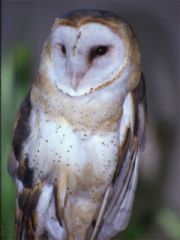
|
Barn Owl: The Barn Owl inhabits open or partially open country, where suitable nest sites are available. It generally avoids wooded habitats, preferring instead farmlands, meadows, and towns. It hunts by flying over open habitat searching for small rodents its primary prey item. Barn Owls feed on whatever food is available and small enough to be taken. In addition to small rodents, insects, and amphibians, birds are also taken.
The nest site, in a tree cavity, rock crevice, abandoned machinery, or old building, is usually unlined, but occasionally bits of wood, twigs and other similar materials are placed on the floor. The eggs are white and somewhat more elliptical than those of most other owl species. Usually 5 to 7 eggs comprise a clutch, but up to as many as 11.
|

WATER BIRD Identification in Northeast Florida
In Flight
|
Perched
|
Description
|
|

|
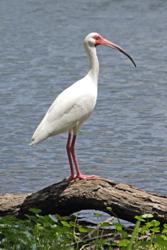
|
White Ibis: They feed primarily on aquatic prey, including crayfish, crabs, insects, snakes, anurans, and fish. They usually breed in mixed-species colonies located over standing water, within freshwater marshes or ponds, or on coastal islands. Nesting occurs in trees, shrubs, cactus, and grass clumps, from ground level to a height of 15 m (50 ft). The nests are round in shape and constructed of sticks, bent rushes, leaves, and roots. Clutches are 1 to 4 (usually 2 or 3) cream-to-greenish-colored eggs, speckled with brown, black, and reddish spots. Incubation requires 21 to 22 days, and the young are able to leave the nest at 9 to 16 days of age. Independence from parents, however, does not occur until 40 to 50 days of age.
Nesting typically extends from March to August. Breeding colonies are often quite large (up to many thousands of nests).
|
|

|

|
Roseate Spoonbill: Its flattened, spatulate bill, specialized feeding technique, and remarkable pink plumage make it unique among Florida's waders. Roseate Spoonbills are primarily nocturnal and crepuscular (dawn and dusk) feeders and favor protected flats and tidal creeks during falling tides. Sweeping their bills back and forth like scythes, they capture small fish, crustaceans, and insects. When severe dry seasons cause falling water levels in freshwater wetlands and retention ponds, spoonbills may regularly exploit inland foraging areas near the coast. Breeding occurs on small mangrove keys or artificial dredged-material islands along the coast. Nests are bulky structures of sticks, lined with finer materials, and are placed beneath the tree canopy.
|
|

|
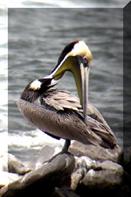
|
Brown Pelican: Brown Pelicans are generally found in coastal near shore habitats, such as along beaches, sandbars, docks, dredge-spoil islands, and diving for prey in most near shore waters. Brown Pelicans nest primarily in trees on coastal islands, in colonies of a few dozen to several hundred pairs. A few colonies may contain more than 1,000 nests. Nests are bulky structures of sticks with an inner cup of finer materials, usually green leaves. Two to 3, mostly 3, white eggs are laid, and incubation takes about 30 days. Nestlings fledge in about 12 weeks. Brown Pelicans feed primarily on several species of fish that occur near the water's surface, including menhaden, mullet, Atlantic threadfin, sea trout, spot, pinfish, sardines, and bay anchovy.
|
|

|
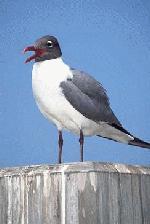
|
Laughing Gull: A small coastal gull. The dark mantle blends into black wing tips. White edge on rear of wing. In summer, head black; in winter, white with dark smudge. Immature: First year; very dark with a white rump and a white border on the trailing edge of the wing. Second year; Paler or whiter on the chest and forehead.
Voice - A strident laugh, ha-ha-ha-ha-ha-haah-haah-haah, etc. It lives in salt marshes, lakes; in winter, coasts, and ocean.
|
|

|

|
Terns: Royal, Least, Sooty, Sandwich… All look fairly similar. Royal Terns breed at great densities; therefore, a large Royal Tern colony is highly conspicuous. In Florida 90% of Royal Tern nests contain only 1 egg, which is incubated for 20 to 22 days. The young form a creche (flock) on the beach, where they are fed by adults who recognize their offspring by voice. The chicks fly 28 to 35 days after hatching.
Food is primarily fish and shrimp. Royal Terns occur along the full coast of Florida; occasionally they are found inland around large lakes, September through April.
|
|

|

|
Sandpipers (Willet): Again many types but same basic look and habits. They are those little birds running all over the beach. The diet of the Willet is composed of invertebrates and, rarely, fish. Fiddler crabs are the most common food item. Other crabs, mollusks, crayfish, and insects make up the remainder of its diet.
The Willet is a semi colonial breeder, in the sense that several pairs often nest closely together. The birds lay 3 to 5 eggs, spotted with brown, varying from olive to sky-blue. Incubation takes 22 to 29 days, but the age at which young first fly is unknown.
|
|

|
|
Egrets & Herons: Great Blue Heron - (African Goliath Heron) - Great White Egret - Little Blue Heron - Tricolor Heron - Snowy Egret
- Reddish Egret - Cattle Egret - Green Heron
Herons and Egrets are long-legged, long-necked and generally long-billed birds. They are largish birds ranging in size from 15 inches long (Rufous-bellied Heron) to 55+ inches long (Goliath Heron). They are all carnivorous most feeding in or near water taking fish, frogs, lizards and insects. A number of species prefer to feed on land taking a variety of lizards, snakes and insects depending on their size.
They use a variety of hunting techniques ranging from standing still at the edge of, or in some water waiting to spear a fish, through acts like stirring the water or grass with a foot or flicking the wings, to disturbing or startling prey, to walking rapidly through the environment. Prey flushing actions such as 'Foot Stirring' and 'Wing-flicking' can be used in conjunction with a slow walk or a walk-stop-walk-stop hunting method as well as when standing still. Though most species feed on aquatic or terrestrial animals some species are happy to snap up flying insects as well or specialize on crabs, or even as nest robbers feeding heavily on both eggs and nestling.
|
|

|
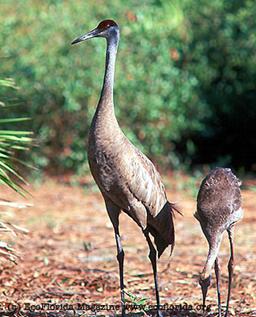
|
Sandhill Cranes: The Sandhill Crane is one of the largest breeding birds in Florida and is easily located by their large size and loud trumpeting call. Habitat includes wet and dry prairies and Cranes nest in herbaceous wetlands associated with freshwater ponds or marshes.
Pair bonding occurs as early as 2 years of age. The nest is built by both adults, generally in wet areas, of sticks, reeds, grasses, and mosses. Nest bulk may depend on elevation or wetness of the site. Two buff-to-olive eggs marked with olive-brown are laid a few days apart, and incubation, shared by both parents, takes 28 to 32 days.
Downy young leave the nest site in a couple of days, but remain near the nest marsh for the first 10 to 14 days, after which they begin self-feeding. Fledging occurs at about 67 days, and young may stay with parents up to 10 months.
|
Common Birds
|
Blue Jay
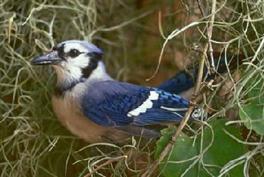
|
Robin

|
Mocking Bird
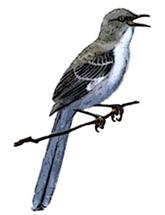
|
Pileated Woodpecker

|
|
Cardinal

|
Redheaded Woodpecker

|
Carolina Wren

|
Brown Thrasher

|
|
Common Grackle

|
Ruby Throated Hummingbird

|
Mourning Dove

|
Turkey

|
Common Insects
|
Dragon Flies

|
Spiny-backed Orb-weaver 
|
Lady Bug
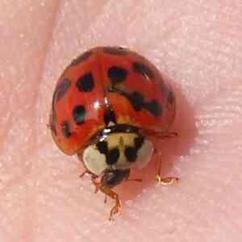
|
Click Beetle
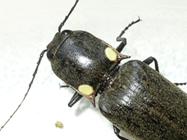
|
|
June Beetle

|
Rhinoceros Beetle

|
Milkweed Bug
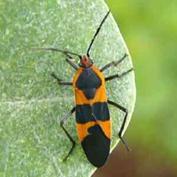
|
Stink Bug

|
|
Praying Mantis
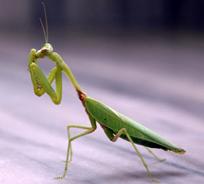
|
Palmetto Bug

|
Firefly
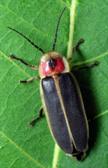
|
Banana Spider

|
USEFUL LINKS
Animal Tracks In The Sand - http://www.archbold-station.org/discoveringflscrub/unit1/partb.html
Tracks, Scat, and General Information - http://www.bear-tracker.com/
For birds, you are best off getting a Birding Chart or Guidebook. Audubon (http://www.audubon.org/) makes some great ones.
Online Guide to Florida Snakes - http://www.flmnh.ufl.edu/herpetology/FL-GUIDE/onlineguide.htm
GAMES & ACTIVITIES
Hunting Spiders at night wearing a headlamp – Wandering spiders like the wolf spiders and fisher spiders may be spotted with head lamps. The beam should be aimed at the ground or toward low vegetation about fifteen feet ahead of you. Move the beam very slowly until you see a small shining spot resembling a tiny green star--the spider's eyes. Move toward the spot carefully, making sure not to lose it. The spider seems to be blinded and will not move as actively as when you approach one during the day. When close enough, capture the spider in a bottle. The easiest way is to invert the bottle and quickly place it over the creature.
Nature Study - While on a hike the Scoutmaster announces that he will give points for the identification of trees, flowers, birds, ferns and animals. The number given will be decided by the Scoutmaster and will depend upon how difficult he considers the identification to be. The season will also govern this. For instance, a tree is harder to identify without the leaves, and a flower out of season might be difficult to place. At the end of a certain time, say 15 minutes, the Scout with the most points wins.
Animal/Plant ID Bingo – Useful on a hike or a drive or at a campsite, but takes some preparation. Fabricate some Bingo-style cards with various plants and animals, and then disperse the scouts to complete their cards (on a campout). The plants and animals selected would need to be tailored to season and locale.
Digital Safari - Have the Scouts use a digital camera and bring the images to you! Send them out with a list, or have them shoot what they see and bring them back to you. You can format this as a race, relay, scavenger hunt, you name it!
Tracking the Game Game – Find some good tracks near camp (deer, raccoon, possum, etc.) and have the Scouts follow them as far as they can.
Troop ID Book – Have the Historian assemble pressed leafs, photos of plants, animals, tracks, and scat, etc., and prepare a guidebook for the troop to use for training younger Scouts.